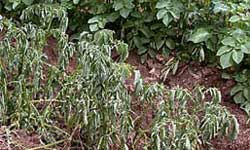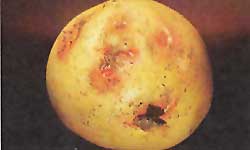Bacterial wilt of potatoes
Bacterial wilt is caused by a soil-borne bacterium named Ralstonia solanacearum (formerly known as Pseudomonas solanacearum). Potato wilt bacterium mainly inhabits the roots, and enters the root system at points of injury caused by farm tools or equipment and soil pests.
On potato, bacterial wilt is also known as:
- brown rot
- southern wilt
- sore eye
- jammy eye.
Bacterial wilt is a serious problem in many developing countries in the tropical and subtropical zones of the world. It has been recorded in all Australian states except Tasmania.
Economic impact of bacterial wilt
Bacterial wilt is one of the most destructive diseases of the potato. It's responsible for causing considerable losses to the potato industry where the disease exists. The disease can cause total loss of a crop and prevent the use of land for potato production for several years.
Host plants
Bacterial wilt attacks more than 200 species. Economically important hosts include:
- banana
- beans
- eggplant
- peanut
- pepper
- potato
- tobacco
- tomato.
Two common weed hosts that are attacked by the disease are:
- nightshade
- thorn apple.
Environmental conditions
Bacterial wilt of potato is generally favoured by temperatures between 25°C and 37°C. It usually doesn't cause problems in areas where mean soil temperature is below 15°C.
Under conditions of optimum temperature, infection is favoured by wetness of soil. Once infection has occurred, symptoms will often be more severe with hot and dry conditions, which hastens wilting.
Symptoms of bacterial wilt
The following symptoms can indicate bacterial wilt on the plant:
- wilting (figure 1)
- yellowing
- some stunting of the plants
- die-back of plants.
Wilting is first seen as a drooping of the tip of some of the lower leaves similar to that caused by a temporary shortage of water. At first only one branch in a hill may show wilting.
 Affected leaves later become permanently wilted and roll upwards and inwards from the margins. The wilting then extends to leaves further up the stem and is followed by a yellowing of the leaves.
Affected leaves later become permanently wilted and roll upwards and inwards from the margins. The wilting then extends to leaves further up the stem and is followed by a yellowing of the leaves.
This yellowing, wilting and in-rolling of the leaves makes diseased plants very obvious, especially when surrounded by healthy plants. The leaves finally turn brown and fall off, beginning at the base of the stem and continuing upwards.
In the tuber, symptoms of bacterial wilt include:
- brownish-grey areas seen on the outside, especially near the point of attachment of the stolon (figure 2)
- bubbly globules of bacteria may discharge through the eyes (as the disease progresses)

- soil may be stuck to the bacterial ooze on the eyes (this is the reason for the disease's alternate names 'sore eyes' or 'jammy eyes')
- in cut tubers, pockets of white to brown pus or browning of the vascular tissue which, if left standing, may discharge dirty white globules of bacteria (figure 3).
Spread of disease
The bacteria is spread by:
- irrigation water and flood waters
- contaminated soil
- nematodes
- infected equipment (seed-cutters, or second-hand bags or half-tonne bins)
- seed dissemination.
Infected seed is an important method of dissemination, both locally and over considerable distances. Self-sown potatoes are extremely difficult to eradicate. If a paddock is infected, the disease can remain in it for 5 or 6 years after the initial outbreak.
Slightly infected tubers that show no visible symptoms pose more of a threat than heavily infected tubers. This is because heavily infected tubers usually rot away and contaminate only the land in which they're grown.
Growers must be aware of these risks and take precautionary measures to prevent the disease and control the spread.
Survival of disease
The wilt bacterium is able to survive for periods up to 2 to 3 years in bare fallow soils, and for longer periods in soils cropped to non-solanaceous crops.
Preventing bacterial wilt
Use the following control measures to help prevent bacterial wilt:
- Rotate crops with pastures, cereals and non-solanaceous crops for periods of more than 5 years.
- Use certified seed from reliable sources.
- Plant in areas where bacterial wilt hasn't occurred previously.
- Control self-sown potatoes.
- Control weed hosts (such as nightshade and thorn apple) along channels and in the paddocks after cropping potatoes.
- Avoid deep ploughing – the organisms survive in the deep, cool layers of soil.
- Don't allow irrigation water to run freely over or below the soil surface or return to the dam or stream from which it is pumped (or to any other irrigation source).
- Inspect crops regularly for disease symptoms and remove and destroy diseased plants, tubers and immediate neighbours.
- Use stock to clean up chats, discarded tubers and crop debris, but don't allow the stock back onto clean paddocks.
- Don't return potato waste – for example, oversized, misshapen and diseased tubers to paddocks.
Controlling the spread of bacterial wilt
Bacterial wilt is difficult to control and eradicate because of the soil-borne nature of the bacteria. The following control measures can help minimise the spread of bacterial wilt.
Machinery, bags and equipment
- Leave machinery taken onto a diseased paddock on the paddock while it's being worked.
- Clean and disinfect machinery removed from the paddock with a disinfectant solution in an area dedicated to equipment wash-down.
- Use high-pressure wash to clean machinery, sheds and other equipment to remove soil stuck to any surfaces.
- If you've used second-hand bags or half-tonne bins to hold potatoes, wash and disinfect them thoroughly before using them again. Bags should be disinfected or discarded.
Vehicles
- Load and unload vehicles only in designated areas with sealed or hard ground or bare paddocks away from potato paddocks.
- Choose transport routes that minimise travel through potato paddocks and regions.
Clothing and boots
- Make sure people working in the paddock change into clean clothing and boots when leaving the paddock. Or, wash boots in a suitable disinfectant.
- Make sure visitors, contractors and workers wear overalls, gumboots and overshoes on the property.
Diseased produce
- After harvest, collect and bury all diseased and discarded tubers at least 1 metre underground.
- Don't keep any of the produce from a diseased crop as seed.
Reporting an unusual plant insect pest or disease
Report any unusual plant pest or disease immediately using our online reporting form or by calling the Exotic Plant Pest Hotline on 1800 084 881. Early reporting increases the chance of effective control and eradication.
Please take multiple good quality photos of the pests or damage to include in your report where possible, as this is essential for rapid pest and disease diagnosis and response.
Your report will be responded to by an experienced staff member, who may seek more information about the detection and explain next steps.
Report onlinePhoto credits
Figure 1: photo courtesy of CGIAR.
Figure 2: photo courtesy of Infonet Biovision.
Figure 3: photo courtesy of International Potato Center.
References
Compendium of Potato Diseases (2001) ed. by Stevenson, W.R. and et al, American Phytopathological Society, St. Paul, MN, USA.
Mulder, A. and Trukensteen, L. J. (2005) Potato diseases, 2508 AC Den Haag The Netherlands.
Potato Health management (2008) ed. by Johnson, D.A. American Phytopathological Society, St. Paul, MN, USA.